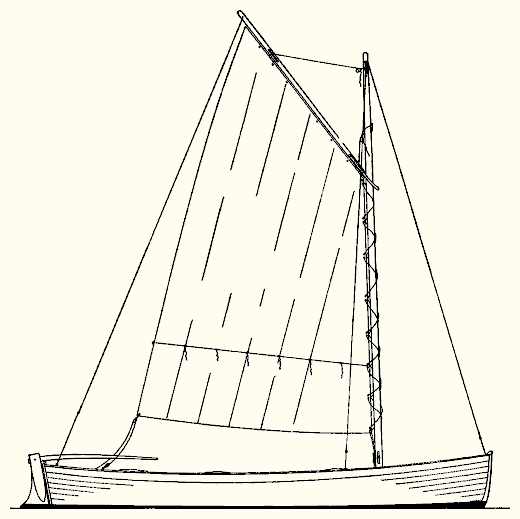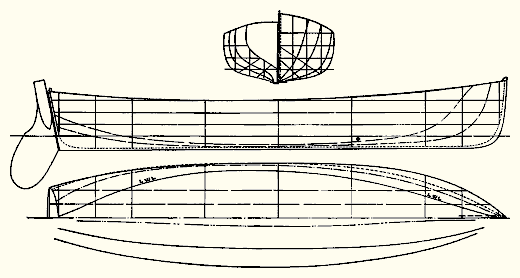

AMONG others there are unfortunately two delightful and health-giving pastimes that the American people are neglecting -- walking and rowing. The facilities for walking are limitless and the equipment for its pursuit nothing beyond a will to walk. Among people that have motor and sailing boats the facilities for rowing are very close at hand -- a dinghy, oars, and again, a will to row.
There was a time when all small open boats were fined-lined jewels designed for easy rowing. During some of the pleasant years I lived at Huntington I owned such a boat. She was a tucked-in-stern lapstrake St. Lawrence River skiff; straight along her keel, firm bilged and a sweet lined little thing. Her length was 12 feet, breadth, 3 feet 9 inches, and draft, 4 inches. It was no effort to pull her along at speeds up to five miles an hour. Her thwarts, row locks, foot boards, and foot braces were perfectly spaced for the comfort of the oarsman. Her long straight keel kept the skiff on her course, the lapped planks contributed to her dryness, the position of the rowing thwart to her perfect balance, and the narrow beam to her speed and practically undisturbed wake. She is one of the two small boats I should not have sold -- the other is the sloop, Great Republic.

Like every thing else in the world there is a right and a wrong way to row and all too few of us know the right way, and, of consequence, the easy way to pull a small boat by means of the oars. I believe it is safe to say that all of us who learned the ways of small boats and the water before the avalanche of outboard motors softened our muscles knew how to row and scull. I do not remember any organized instruction in the matter. Boys simply got into a skiff and experimented, watching in the process, the finesse with which clammers, and other folks around the waterfront behaved with oars. Capt. Frank Ott, of Huntington as of Yesterday, was a joy to watch. He was a small man and always rowed a big skiff -- and how easily it moved along. His oars exactly matched the boat in which he rowed; that is, the length of the oars from the rowlocks to his hands was in correct proportion to the length from the rowlocks to the tips of the blades. And the rowlocks were placed at a convenient distance from the after edge of the rowing thwart, the thwart itself being set well below the gunwales. The correct dimensions for seat depths, oar lock locations, lengths of oars, and other matters which have to do with easy oar pulling were the intangible portions of the skill of boat builders of older times, men like Capt. Joe Tillot, Chas. G. Sammis and many another worthy now gone down the sunset road of time.
If and when you row a boat take your time about it. Haste makes an indifferent oarsman. Do not sweep the blades of the oars in wide circles as though to clear stumps either side the boat; oars are not paddle wheels. Keep the grips close together and do not hang on to them for grim death. Do not plunge the blades deeply into the water. And before the end of each stroke begin to feather the blades, that is, draw them edgeways from the water and with the blades flat with the water surface to avoid windage, let them return for the next stroke. And on the return stroke keep the blades close to the surface; but do not trail or skim them over the surface. The latter is "fancy" rowing. An experienced oarsman pulls, not only with his back, but with his wrists, arms, legs and feet as well. And, as I mentioned before, he should not go at the pastime hammer and tongs.

And so we come to the sailing and rowing boat for beginners, Little Scout. Like the St. Lawrence River skiff I at one time owned, this latest of the family is a fine-lined lapstrake open gunwale boat. The dimensions of this one are: length over all, 15 feet 7 inches; water line length, 15 feet; breadth, 3 feet 10 inches inside sheer mouldings; and draft, with center board up, just 6 inches. The freeboard at the stem is 1 foot 11 1/4 inches, and at the stern, 1 foot 6 1/4 inches. There is a pleasing sheer and enough freeboard along the middle sections to make rowing comfortable. The keel is straight. The boat has a large rudder (a sterling advantage to any useful boat) and an adequate center board. The sail is for auxiliary purposes and modest in area; such should be the sail plan for all beginners in sail. But, unfortunately, this side of the border it is not. It has standing rigging and running rigging which can be played with, knotted, spliced, rove, hauled on, experimented with and otherwise treated as rigging might be used on a sailing ship of the deep sea -- like the rig of the Bounty's launch, if you will. No machine tools needed!
The antecedent of Little Scout was designed for the Twelfth Hamilton Sea Scout Group, The Boy Scouts Association of Canada, Hamilton, Ontario, of which A. Walter Wright is master. Canadian Sea Scouts differ from those in America. The boys are younger than our Sea Scouting young men. The tests are rowing and sailing; but the boys cannot sail until they are finished oarsmen. How different here! Their boats are kept in boat houses and must be light enough to be carried to and from the water by the boys. The scouts also take excellent care of the boats, the boat houses, equipment, and the scout property. All valuable training for boys and men. Capt. Frank Ott told me he first rowed when he was six; and I might add that my first experience with oars was when I was nine. And so it would seem to me that under organized scouting the "nippers" might well first go afloat when much less than 10 years old.

The little boat has room for six very little "nippers," one to each of the six oars; or for three more husky fellows. In both cases the coxswain commands the vessel from the stern sheets -- and away they stand off to sea! But when they sail there will be only four hardy sea-men aboard.